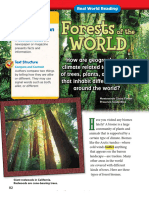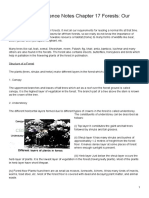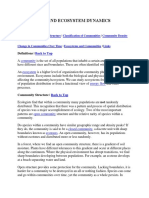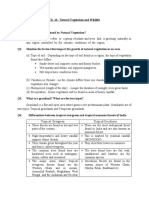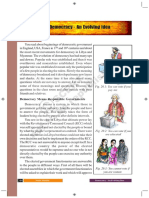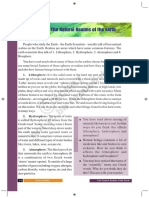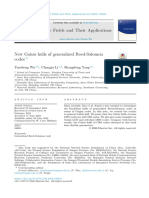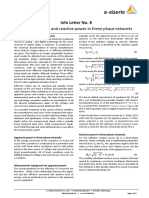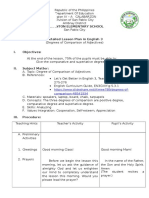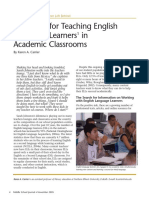Biosphere: Free Distribution by A.P. Government
Biosphere: Free Distribution by A.P. Government
Uploaded by
soundu ranganathCopyright:
Available Formats
Biosphere: Free Distribution by A.P. Government
Biosphere: Free Distribution by A.P. Government
Uploaded by
soundu ranganathOriginal Description:
Original Title
Copyright
Available Formats
Share this document
Did you find this document useful?
Is this content inappropriate?
Copyright:
Available Formats
Biosphere: Free Distribution by A.P. Government
Biosphere: Free Distribution by A.P. Government
Uploaded by
soundu ranganathCopyright:
Available Formats
CHAPTER
Biosphere
5
The Earth is a unique planet, in that it has life thriving on it. It is inhabited by
countless forms of life from microscopic bacteria to great banyan trees and animals
like elephants, tigers and blue whales and of course human beings. The fact that the
earth has a combination of land, air and water, and a moderate temperature due to a
moderate distance from the Sun, has made life possible on it. We saw in an earlier
lesson that life thrives only in the intersection of the three spheres – lithosphere,
atmosphere and hydrosphere. According to many geographers, life itself constitutes
a separate sphere called ‘biosphere’.
All forms of life have an integral connection with the land, air, water and sunshine
around them. They draw their sustenance from them and in turn affect them in
significant ways.
Various forms of life are not only related to the three spheres around them, but
also to each other. They are part of a complex ‘food chain’ – that is one kind of life
becomes the food for another kind.
Many of the life forms also are
Can you say how plants are dependent symbiotic, that is they live by exchanging
upon air and water and how they affect essential substances with each other.
the two in return? Let us consider some examples:
In what ways are insects like mosquitoes The primary food producers are the
and butterflies dependent upon rocks or plants which produce food with the help
soil and upon water? How do they affect of sunlight. The plants themselves draw
them in return? their vital nutrients from the soil,
especially from organic compounds
formed due to decay of other plants and animals. They also depend upon nitrogen
stored in the soil by bacteria. The food produced by the plants are eaten by animals,
usually called ‘herbivores’ or plant eating animals like deer, cattle, goats, elephants
etc. Living beings like dogs, cats, fishes, birds, tigers etc. eat the flesh of herbivorous
animals and in this way are indirectly dependent upon plants. Bacteria and fungi
help in decomposition of dead trees and animals and breaking them down into
organic compounds which the plants draw upon for their growth. Thus the cycle of
life goes on.
Any disturbance in this cycle can create what is called an ‘ecological crisis’.
For example if a particular species which feeds upon a particular kind of plant is
Free distribution by A.P. Government 51
exterminated, it would result in unchecked growth of that plant. It may grow so
much that it may intrude into the area of other plants and stop them from growing.
Another example of disturbance is mixing of some poisonous substances in
air or water or soil. Many industries use chemicals and metals which they allow to
flow into the streams and rivers. This leads to a large increase in the levels of such
chemicals in the water. These metals like mercury are consumed by microorganisms
in water and in turn become the food of a large number of fishes. When human
beings consume these fishes they too absorb quantities of mercury that are
detrimental to their health.
Let us look at another example. Vultures feed upon dead animals like cattle.
Vultures eating dead carcass used to be a common sight in villages and towns some
twenty years ago. However, people started noticing that vultures have virtually
disappeared and are sighted very rarely. Investigations suggest that farmers use a
particular chemical called Diclofenac to treat cattle. When the cattle die their
flesh retains this chemical. When their flesh is consumed by vultures, diclofenac
leads to kidney failure in them and they die within a week or so. In this way vultures
have come very close to extinction.
Since all living and non-living things on the earth are in one way or the other
connected to each other, changes affecting one, in due time affects all others too.
Natural Vegetation
Natural vegetation is generally classified into three broad categories: forests
in areas of sufficient rainfall and sunshine; grasslands in regions of moderate rains;
and shrubs in dry regions. In very cold regions we have tundra vegetation consisting
of small shrubs, moss and lichens. Let us study some of these in greater detail.
As you may remember, there are different kinds of forests, depending upon
climate of the place.
Tropical Evergreen Forests
These forests are also called tropical rainforests. These thick forests occur in
the regions near the equator and close
to the tropics. These regions are hot
and receive heavy rainfall throughout
the year. As there is no particular dry
season, the trees do not shed their
leaves altogether. This is the reason
they are called evergreen. The thick
canopies of the closely spaced trees
do not allow the sunlight to penetrate
inside the forest even in the day time.
Hard wood trees like rosewood,
ebony, mahogany are common here. Fig. 5.1: Tropical Evergreen Forests
52 Social Studies Biosphere
Tropical Deciduous Forests
Tropical deciduous are the
monsoon forests found in the
large parts of India, northern
Australia and in central America
(Fig. 5.2).These regions
experience seasonal changes.
Trees shed their leaves in the dry
season to conserve water. The hard
wood trees found in these forests
are sal, teak, neem and shisham.
Hard wood trees are extremely
useful for making furniture,
Fig. 5.2: Tropical Deciduous Forests transport and constructional
materials. Tigers, lions, elephants,
langoors and monkeys are the common animals of these regions.
Temperate Evergreen Forests
The temperate evergreen forests are
located in the mid latitudinal coastal region
(Fig. 5.3). They are commonly found along
the eastern margin of the continents, for
example in South East USA, South China and
in South East Brazil. They comprise both hard
and soft wood trees like oak, pine, eucalyptus
etc.
Fig. 5.3: Temperate
Evergreen Forests
Temperate Deciduous Forests
As we go towards higher latitudes, there
are more temperate deciduous forests (Fig.
5.4). These are found in the North Eastern
part of USA, China, New Zealand, Chile and
also in the coastal regions of Western
Europe. They shed their leaves in the dry
season. The common trees are oak, ash,
beech, birch etc. Deer, foxes, wolves are
Fig. 5.4: Temperate deciduous forests the animals commonly found. Birds like
pheasants, monals are also found here.
Free distribution by A.P. Government 53
Mediterranean Vegetation
You have learnt that most of
the east and north east margins of
the continents are covered by
temperate evergreen and
deciduous trees. The west and
south west margins of the
continents are different. They have
Mediterranean vegetation.
Mediterranean trees adapt
themselves to dry summers with
the help of their thick barks and
wax coated leaves which help them
reduce transpiration. This is Fig. 5.5: Mediterranean vegetation
mostly found in the areas around
the Mediterranean sea in Europe, Africa and Asia, hence the name. This kind of
vegetation is also found outside the actual Mediterranean region in California in
the USA, south west Africa, south western and South America and South west
Australia. These regions are marked for hot dry summers and mild rainy winters.
Citrus fruits such as oranges, figs, olives and grapes are commonly cultivated here
because people have removed the natural vegetation in order to take up agriculture.
There isn’t much wildlife here.
Coniferous Forests
In the higher latitudes (50° –
70°) of Northern hemisphere the
spectacular Coniferous forests are
found (Fig.5.6). These are also
called as Taiga. These forests are
also seen in the higher altitudes.
These trees are found in the
Himalayas in abundance. They are
tall, softwood, evergreen trees.
These woods are very useful for
making pulp, which is used for
manufacturing paper and newsprint.
Match boxes and packing boxes are
also made from softwood. Chir,
Fig. 5.6: Coniferous forests
pine, cedar are the important trees
in these forests. Silver fox, mink, polar bear are the common animals found here.
54 Social Studies Biosphere
Look around in your surroundings and find out Grasslands
the articles made of hard wood and soft wood. Tropical grasslands: These
Find out and learn few names of trees of your grow on either side of the
locality. equator and extend till the tropics
(Fig. 5.7). This vegetation grows
in the areas of moderate to low
amount of rainfall. The grasses
grow very tall, about 3 to 4 metres
in height. Savannah grasslands of
Africa are of this type. Elephants,
zebras, giraffes, deer, leopards
are common in tropical
grasslands.
Temperate grasslands:
These are found in the mid-
Fig. 5.7: Tropical grasslands latitudinal zones and in the
interior part of the continents
(Fig. 5.8). Usually, grass here is
short and nutritious. Wild
buffaloes, bisons, antilopes are
common in the temperate region.
These ar known as Steppes.
Thorny bushes: These are
found in the dry desert like
regions. Tropical deserts are
located in the western margins of
the continents. The vegetation
cover is scarce here because of
Fig. 5.8: Temperate grasslands
scanty rain and scorching heat.
Identify the desert regions in the world map. Tundra Vegetation: If you
reach the polar region you will
find the place extremely cold. The growth of natural vegetation is very limited
here. Only mosses, lichens and very small shrubs are found here. These grow during
the very short summer. This is called Tundra type of vegetation. This vegetation is
found in the polar areas of Europe, Asia and North America. The animals have
thick fur and thick skin to protect themselves from the cold climatic conditions.
Seal, walruses, musk-oxen, Arctic owl, Polar bear and snow foxes are some of the
animals found here.
Free distribution by A.P. Government 55
Human Society and Environment
Down the ages, human societies have been interacting with the environment
and in this process changing it. Hunters and gatherers used stone tools and tools
made of wood etc. to hunt animals and gather tubers and fruits. They learnt to use
fire – by lighting sticks and grass – the first sources of energy to be used. Thus
began the tale of human endeavour to alter the environment to satisfy their needs.
Human beings also began investigating into the nature of the environment around
them in order to be able to change and use them for their purposes. Thus the building
of knowledge of the environment is an essential part of human beings interaction
with the natural world.
When human beings began to practise agriculture and animal husbandry, they
began to change their environment even more. The building of cities and the use of
metals like bronze and iron further changed human interaction with the environment.
Before long, people began building tanks to store water, canals to divert water
to fields, and even dams across streams and rivers.
People also built roads connecting distant places and sailed in ships and boats
across seas and oceans. In this way human societies established themselves not
only on every continent (except the Antarctic) but over the seas and oceans too.
Gradually human population grew so much so that human beings became the
dominant species on the earth. It is estimated that during BC 10,000 i.e., the time
when cultivation started, the total population of human beings worldwide was about
40 lakhs. It reached to 50 crores in 1750;100 crores in 1800; 250 crores during
1950 and to 700 crores during 2010. It is estimated to reach 1000 crores by 2100.
This increase in population creates great pressure on earth as well as its resources.
This means that almost the entire earth would be reshaped to suit the needs of
humans.
Can you discuss how human beings would
This process of reshaping the have impacted the land, water, plants and
surface of the earth received a great animals around them when they began
push with the industrial revolution agriculture and animal herding?
and process of colonisation.
What sources of energy would they have
Industrial production needs raw
used and how would they have obtained
materials on an unprecedented scale
them?
and industrial countries began to
search for diverse kinds of raw Can you say what kinds of changes will
materials and sources of energy all building of cities have on the land and water
over the globe. They ‘explored’ the around them?
world and made inventories of all In what way do you think this would have
possible resources. They dug deep affected the land scape and water cycle?
56 Social Studies Biosphere
wells and tried to find out what lay underneath and also explored high above in the
atmosphere. Soon systematic mining, cutting of forests, building of factories and
fields and roads took place all over the earth. Nations began to wage wars with each
other to gain control over these resources.
Such intense human industrial activity has profound impact on the air, water
and the land around us. Let us try to think of some of these.
Industries – Pollutants and Effluents
Modern industries and transport systems use immense amount of energy which
is derived basically from coal and petroleum (which are called fossil fuels as they
are remains of forests of lakhs of years ago buried underground). The burning of
fossil fuels release large quantities of carbon dioxide and other chemicals like
nitrogen oxides, sulfur dioxide, volatile organic compounds and heavy metals. They
also cause the release of sulfuric, carbonic, and nitric acids, which cause what are
called ‘acid rains’. Acid rains are caused by the mingling of acidic particles of
atmosphere with rain increasing the acid content of rain water.
In addition to burning of fossil fuels,
KYOTO PROTOCOL modern industries release enormous
amounts of waste materials in the form of
A conference was held in the city of Kyoto in solid, liquid and gaseous waste
Japan under United Nations Organisation in contaminating air, water (both surface
December 1997 to protect mother earth
water like rivers and underground water of
from global warming. The countries that
wells) and soil.
attended realised the effect of Green House
Gases and signed a declaration called Kyoto The cumulative impact of such
Protocol. The main aim of this is to bring pollution is gradually poisoning of our
down the release of Green House Gases to environment. One important impact is the
less than 5.2%. According to this declaration, change in worldwide climate also called
this aim should be achieved between 2008- ‘global warming’. Let us read about this in
2012. greater detail in Class IX biological
science at Chapter X.
Depletion of Resources
Industrialisation, rapid population growth and urbanisation all have meant
unprecedented exploitation of natural resources like minerals, forests, soil, water,
air etc. besides sources of energy (coal, petroleum etc.) stored in the earth for
billions of years. This has resulted in rapid deforestation and decline of reserves
of minerals, oil and groundwater. Many scientists have argued that the present way
of life is not ‘sustainable’ for if we use so much natural resources, nothing will be
left for our children and grand children.
Free distribution by A.P. Government 57
All the living beings on the earth Do You Know?
depend on the environment and have to
live according to the environment. But, 1. Approximately 13-15 tonnes of effluents,
for their enjoyment and development sewage water reach Kolleru lake daily from
human beings are destroying nature. its nearby towns and villages.
The commercial activities carried on 2. One study found taht the radiation
by human beings are affecting every life released by cell phone towers affects the
and every matter on the earth. If this life of honey bees. This leads not only to
continues like this it is dangerous not scarcity of honey but also affects
only to animals but also to human pollination and bio diversity and here
beings themselves. agricultural products.
Key words
1. Food chain 2. Hard wood trees 3. Acid rains
4. Ecological crises 5. Tundra
Improve your learning
1. Life itself constitutes a seperate sphere called ‘Biosphere’. Explain.
2. Why is ecological crisis created in modern times? What are its effects?
3. Natural vegetation depends upon the climate of the place. Write different kinds of
forests and climatic conditions of their existence?
4. How can we protect natural resources?
Project
Visit any nearby industrial establishment and observe what kinds of smoke, liquid
and solid wastes come out of the compound. Find out from the nearby residents
about their impact on plants and animals. Based on the information collected, prepare
a report and present in the class.
58 Social Studies Biosphere
You might also like
- Case 2B-Nils BakerDocument3 pagesCase 2B-Nils BakerKevval BorichaNo ratings yet
- 238 Preventive Check Sheet of Press Brake MachineDocument4 pages238 Preventive Check Sheet of Press Brake MachineAjay100% (3)
- Trees and Forests Unit ReviewDocument10 pagesTrees and Forests Unit Reviewapi-270167026No ratings yet
- Asme y 14.5.1M-1994 (En) - 2004Document92 pagesAsme y 14.5.1M-1994 (En) - 2004Robert Marsella100% (4)
- The Modern French Volume 2 Advance and Winawer - Dmitry Kryakvin PDFDocument437 pagesThe Modern French Volume 2 Advance and Winawer - Dmitry Kryakvin PDFTuan Pham100% (6)
- 9th Class-TS-EM-Social Studies-5 - BiosphereDocument8 pages9th Class-TS-EM-Social Studies-5 - BiosphereSiddhenki StephenNo ratings yet
- Group 4 - Narattive ReportDocument6 pagesGroup 4 - Narattive ReportJodie Mer DayamaNo ratings yet
- Unit 7 PDFDocument17 pagesUnit 7 PDFashishNo ratings yet
- We and Our World 2Document66 pagesWe and Our World 2Technical Section- Sr.DEE/G/ASNNo ratings yet
- Forest - Ourlife LineDocument5 pagesForest - Ourlife Linefebinstr339No ratings yet
- Forest EcosystemDocument21 pagesForest Ecosystemsunny_live0992% (12)
- Forest: Our Lifeline: by Abishek ThiyagarajanDocument10 pagesForest: Our Lifeline: by Abishek ThiyagarajanAbishek ThiyagarajanNo ratings yet
- Geography Natural VegetationDocument2 pagesGeography Natural VegetationSayona SinhaNo ratings yet
- Natural Vegetation and Wildlife - Class - 7Document24 pagesNatural Vegetation and Wildlife - Class - 7arnav upadhyayNo ratings yet
- Terrestrial HabitatDocument4 pagesTerrestrial HabitatmadzNo ratings yet
- Types of ForestsDocument5 pagesTypes of ForestsNamit100% (1)
- 7geojaya 6Document8 pages7geojaya 6dsfNo ratings yet
- What Are The Major Types of Terrestrial EcosystemsDocument7 pagesWhat Are The Major Types of Terrestrial EcosystemsMarvin LapuzNo ratings yet
- Rainforests in IndiaDocument6 pagesRainforests in IndiaSPREAD RED DGPNo ratings yet
- Natural Vegetation and Wild Life: Let's DoDocument16 pagesNatural Vegetation and Wild Life: Let's Douttam jangraNo ratings yet
- CH 17 Forest Our LifelineDocument25 pagesCH 17 Forest Our Lifelinesujeet Kumar SinghNo ratings yet
- Natural Vegetation and Wild Life - NotesDocument5 pagesNatural Vegetation and Wild Life - NotesTyprix IseeNo ratings yet
- Forest Our LifelineDocument17 pagesForest Our LifelinePavani KumariNo ratings yet
- Terrestrial Ecosystem: Forest: ComponentsDocument4 pagesTerrestrial Ecosystem: Forest: ComponentsMich ElleNo ratings yet
- Seasonal ForestDocument14 pagesSeasonal ForestRio TomatoNo ratings yet
- Vdocument - in - Deciduous Forests 5685a41592950Document34 pagesVdocument - in - Deciduous Forests 5685a41592950sudhanshuraj0fficial18No ratings yet
- CHP 16 Natural Vegetation and WildlifeDocument5 pagesCHP 16 Natural Vegetation and WildlifeUnubala SenapatyNo ratings yet
- Compare and Contrast ReadingDocument8 pagesCompare and Contrast ReadingSu MyatNo ratings yet
- CH-17 Forest-Our LifelineDocument12 pagesCH-17 Forest-Our LifelineRAJESH JAINALNo ratings yet
- SCRIPT 11 ch-3c200228090902020606Document10 pagesSCRIPT 11 ch-3c200228090902020606rudrakumar2236No ratings yet
- Lecture 09Document34 pagesLecture 09BakeNo ratings yet
- ForestsDocument2 pagesForeststhasya.angel17No ratings yet
- Forest: Coniferous ForestsDocument3 pagesForest: Coniferous ForestsRutuja BhalekarNo ratings yet
- ForestDocument2 pagesForestAndri Fatihatal PutraNo ratings yet
- Biology: Specific ObjectivesDocument8 pagesBiology: Specific ObjectivesCarlos Felino LazatinNo ratings yet
- Natural Vegetation and Wildlife of IndiaDocument13 pagesNatural Vegetation and Wildlife of Indiapiyushhota65% (17)
- Class 7 Notes Science - Chapter 16,17Document10 pagesClass 7 Notes Science - Chapter 16,17Siddavatam PrasanthiNo ratings yet
- Forests: Our Life Line: Biology ActivityDocument10 pagesForests: Our Life Line: Biology Activityad9iNo ratings yet
- Tropical Evergreen Forests Are A Dominant Part of The Natural Vegetation in IndiaDocument13 pagesTropical Evergreen Forests Are A Dominant Part of The Natural Vegetation in IndiaPARDEEP RATHINo ratings yet
- Ecosystem - Major Types 2024Document3 pagesEcosystem - Major Types 2024Sheryn Mae GalendezNo ratings yet
- Presentation 1Document19 pagesPresentation 1Gaurav PatilNo ratings yet
- CLASS 7 Chapter 15 FORESTDocument7 pagesCLASS 7 Chapter 15 FORESTsiddharthsg37No ratings yet
- Ecosystem TypesDocument9 pagesEcosystem TypesJaffy BustamanteNo ratings yet
- ForestDocument40 pagesForesttanbir singhNo ratings yet
- Best Animal BiomesDocument6 pagesBest Animal Biomessalman672003No ratings yet
- 2.1 Ecosystems of The Planet - Knowledge Organiser 2Document6 pages2.1 Ecosystems of The Planet - Knowledge Organiser 218gmillsNo ratings yet
- FORESTRYDocument10 pagesFORESTRYkwambokasly21No ratings yet
- Terrestrial EcosystemDocument6 pagesTerrestrial EcosystemJaykumar 003No ratings yet
- Ecology CycleDocument30 pagesEcology CycleNiko Jay RojasNo ratings yet
- Deciduous ForestDocument23 pagesDeciduous ForestDanielle AboyNo ratings yet
- ACTIVITY3Document3 pagesACTIVITY3BS PSY Richelle Mae AndesNo ratings yet
- Notes Natural VegetationDocument3 pagesNotes Natural VegetationannaNo ratings yet
- Notes Natural VegetationDocument3 pagesNotes Natural VegetationannaNo ratings yet
- Forest EcosystemDocument12 pagesForest EcosystemAlysa Shereen Alba FerrierNo ratings yet
- Environmental Science and Engineering SCHX1001 Course MaterialDocument41 pagesEnvironmental Science and Engineering SCHX1001 Course MaterialCharan SaiNo ratings yet
- Online AssignmentDocument16 pagesOnline Assignmentappu27m2000No ratings yet
- Forest and Wild Life in India BasicDocument8 pagesForest and Wild Life in India BasicRRSNo ratings yet
- Temperate ForestDocument4 pagesTemperate ForestCaped BaldyNo ratings yet
- ForestsDocument32 pagesForestsYounus AkhoonNo ratings yet
- Chapter 6Document8 pagesChapter 6Sati KumNo ratings yet
- Chapter 6. BiomesDocument68 pagesChapter 6. BiomesjijiNo ratings yet
- Inside the Forest Kingdom - From Peculiar Plants to Interesting Animals - Nature Book for 8 Year Old | Children's Forest & Tree BooksFrom EverandInside the Forest Kingdom - From Peculiar Plants to Interesting Animals - Nature Book for 8 Year Old | Children's Forest & Tree BooksNo ratings yet
- Expansion of Democracy: LibyaDocument11 pagesExpansion of Democracy: Libyasoundu ranganathNo ratings yet
- Human Rights and Fundamental Rights: What Are The Rights?Document13 pagesHuman Rights and Fundamental Rights: What Are The Rights?soundu ranganathNo ratings yet
- ENVIRONMENT 1 Unit XDocument7 pagesENVIRONMENT 1 Unit Xsoundu ranganathNo ratings yet
- Democracy - An Evolving Idea: Democracy Means Responsible GovernmentsDocument11 pagesDemocracy - An Evolving Idea: Democracy Means Responsible Governmentssoundu ranganathNo ratings yet
- Environment 135Document15 pagesEnvironment 135soundu ranganathNo ratings yet
- Environment 198Document14 pagesEnvironment 198soundu ranganathNo ratings yet
- Environment 3Document8 pagesEnvironment 3soundu ranganathNo ratings yet
- Democratic and Nationalist Revolutions: 19th CentuaryDocument13 pagesDemocratic and Nationalist Revolutions: 19th Centuarysoundu ranganathNo ratings yet
- Environment 176Document12 pagesEnvironment 176soundu ranganathNo ratings yet
- Social Protest Movements: Fig. 16.1: Lane in Poorer Quarters of London. French Artist Dore 1876Document8 pagesSocial Protest Movements: Fig. 16.1: Lane in Poorer Quarters of London. French Artist Dore 1876soundu ranganathNo ratings yet
- Changing Cultural Traditions in Europe 1300-1800Document16 pagesChanging Cultural Traditions in Europe 1300-1800soundu ranganath100% (1)
- Environment 9Document21 pagesEnvironment 9soundu ranganathNo ratings yet
- Service Activities in India: What Is A Service Activity?Document9 pagesService Activities in India: What Is A Service Activity?soundu ranganathNo ratings yet
- Environment 8Document16 pagesEnvironment 8soundu ranganathNo ratings yet
- Unit G PDFDocument26 pagesUnit G PDFsoundu ranganathNo ratings yet
- Environment 1Document12 pagesEnvironment 1soundu ranganathNo ratings yet
- Unit 17Document12 pagesUnit 17soundu ranganathNo ratings yet
- Unit IDocument20 pagesUnit Isoundu ranganathNo ratings yet
- Unit JDocument30 pagesUnit Jsoundu ranganathNo ratings yet
- Unit FDocument24 pagesUnit Fsoundu ranganathNo ratings yet
- Unit HDocument20 pagesUnit Hsoundu ranganathNo ratings yet
- Unit IDocument20 pagesUnit Isoundu ranganathNo ratings yet
- Unit BDocument32 pagesUnit Bsoundu ranganathNo ratings yet
- The Elements of Geometry: 3.1 IIIIIDocument12 pagesThe Elements of Geometry: 3.1 IIIIIsoundu ranganathNo ratings yet
- Unit eDocument17 pagesUnit esoundu ranganathNo ratings yet
- Unit DDocument36 pagesUnit Dsoundu ranganathNo ratings yet
- Usage of Additive Manufacturing in The Automotive IndustryDocument12 pagesUsage of Additive Manufacturing in The Automotive IndustryNasim HossainNo ratings yet
- QUANTITATIVE RESEARCH: Characteristics, Strengths, Weaknesses (WEEK 1)Document12 pagesQUANTITATIVE RESEARCH: Characteristics, Strengths, Weaknesses (WEEK 1)Hanna Shane EsplanaNo ratings yet
- New Galois Hulls of Generalized Reed-Solomon CodesDocument12 pagesNew Galois Hulls of Generalized Reed-Solomon CodesMarvin OlavidesNo ratings yet
- The English Home - April 2016Document164 pagesThe English Home - April 2016Kai100% (1)
- Apparent Power and Reactive Power in Three-Phase NetworksDocument4 pagesApparent Power and Reactive Power in Three-Phase Networks1981todurkarNo ratings yet
- Edexcel Cert Single Award Biol SOW KBI0 CVRDocument31 pagesEdexcel Cert Single Award Biol SOW KBI0 CVRFathimath IrashaNo ratings yet
- Guidelines For Completing The Volleyball ScoresheetDocument22 pagesGuidelines For Completing The Volleyball ScoresheetIanne SantorNo ratings yet
- Design of Helical Pier Foundations in Frozen GroundDocument6 pagesDesign of Helical Pier Foundations in Frozen GroundCortesar ManuNo ratings yet
- Talent Management FrameworkDocument16 pagesTalent Management FrameworkIsland RockyNo ratings yet
- Metal and Non Metal NotesDocument13 pagesMetal and Non Metal NotesShabad SinghNo ratings yet
- Detailed LP For Comparison of AdjectivesDocument9 pagesDetailed LP For Comparison of Adjectivesenisthename100% (3)
- Equip. Note PDFDocument16 pagesEquip. Note PDFhailush girmay100% (1)
- Key Issues in Language LearningDocument6 pagesKey Issues in Language Learningelzahraa elzahraaNo ratings yet
- Principles of TaxationDocument11 pagesPrinciples of TaxationJay GamboaNo ratings yet
- D7R Series II Track-Type Tractor Electrical System Differential SteerDocument2 pagesD7R Series II Track-Type Tractor Electrical System Differential SteerMauricio BellidoNo ratings yet
- Lesson 3 Network Connectivity and People Behind The SystemsDocument3 pagesLesson 3 Network Connectivity and People Behind The SystemsMr.CinnamonNo ratings yet
- Oil Tables 54B - DDocument10 pagesOil Tables 54B - DSergey ChernovNo ratings yet
- Biomedical Science Coursework HelpDocument7 pagesBiomedical Science Coursework Helpdrrzjaifg100% (2)
- Matlab For Machine LearningDocument10 pagesMatlab For Machine Learningmm naeemNo ratings yet
- Ket 3Document29 pagesKet 3Jose TorresNo ratings yet
- Installation, Operations & Maintenance Manual: Invertronic 3P/0-028-0009-900 Rev. FDocument99 pagesInstallation, Operations & Maintenance Manual: Invertronic 3P/0-028-0009-900 Rev. FAlejandro Garcia MNo ratings yet
- Syllabus Semester 4 HRMDocument5 pagesSyllabus Semester 4 HRMJeyNo ratings yet
- Wuttering HeightsDocument18 pagesWuttering HeightsFirst LastNo ratings yet
- KT Ichimoku EADocument7 pagesKT Ichimoku EAdnsptra_580883023No ratings yet
- SyllabusDocument9 pagesSyllabuswgcvNo ratings yet
- Formwork System For Buildings PDFDocument51 pagesFormwork System For Buildings PDFEdward C100% (2)



























